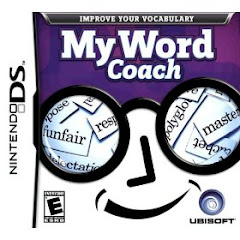There are many “My Coach” games for Nintendo DS and even some for Wii. Top of my list to consider is My SAT Coach. It was released last September and is a single player game for the DS. One thing to mention right away is that there are no extra save spots. Only one person can play this and their progress is recorded automatically. If anyone else plays it that will “taint” the original player’s scores. So buy it for one person. My SAT Coach is designed to help people learn and/or to improve their SAT test scores. Here is the key feature list for the game:
* Build Knowledge - Practice key skills and subjects in all the different subsections of the SAT test or gauge your knowledge by taking a sample test from The Princeton Review
* Follow-Up - Track your overall progress in all SAT topics including arithmetic, geometry, algebra, critical reading, writing and vocabulary
* Prepare - Engage in a series of mini-games that will help you increase your level of judgment, confidence and time management - everything you need to boost your SAT score. Learn about helpful methods and mental approaches to reduce stress and ensure you are physically and mentally prepared
* Mini-Game Drills - Train yourself in mathematics to elude the tricks of the SAT. Train yourself in vocabulary and grammar. Learn helpful methods to improve time management and reduce stress
* Personal Follow-Up - Track your progress in quizzes and follow recommendations to boost your strengths and minimize your weaknesses
The biggest drawback is the game does not tell you how to solve the problems. If you don’t know an Algebra problem, it won’t tell you how to solve the problem. It will only give you the right answer. Remember, this game is primarily for improving test taking skills, not on improving the student’s knowledge in a subject area. There are training sections for each part of the SAT and the player can take the whole SAT, with opportunity to save between sections. Here are the different sections:
- CRITICAL READING - Quiz yourself on Sentence Completion and Passage-Based questions.
- MATHEMATICS - Math quizzes--Arithmetic, Basic Algebra, Geometry and Miscellaneous--are located here.
- WRITING - writing portion of the SAT--Sentence Errors, Improving Sentences and Improving Paragraphs
- TAKE THE SAT TEST - Do the real thing! The SAT takes 3 hours and 45 minutes, but don’t worry, My SAT Coach lets you save between sections.
POSITIVE/NEGATIVE – Identify whether each word has a positive or a negative connotation - MATH ACE - Quiz to help improve timing and think quickly in general math.
- ALGEBRA BLITZ - Quiz to help improve timing and think quickly in Algebra.
- ELIMINATION – game with training for eliminating wrong answers in all sections of SAT (math, critical reading, and writing).
- GRAMMAR CRACKER – timed game where area is highlighted and player must identify the type of grammatical error-- Verb Tense, Idioms, Subject Verb Agreement, False Comparison or “No Error”.
- DEFINITION DECODER – Timed game where the player chooses which of two words the given definition is describing.
For the student who just needs practice before the real thing, this is good way to do it. Games run about $20 new and many game stores sell used ones for much less.

